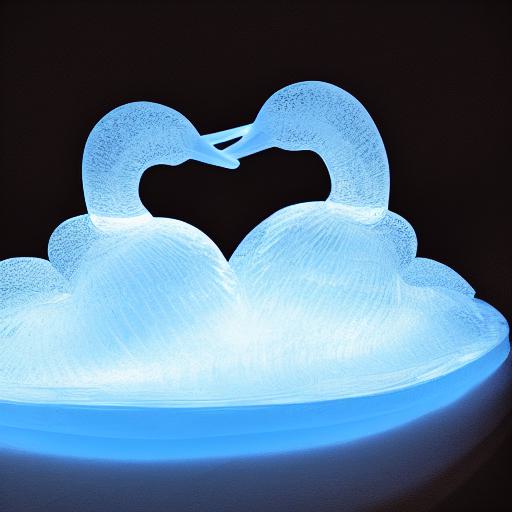How to write this prompt?
The prompt is composed of several parts that influence the generated image. Let’s break it down:
- “an tranquil ice sculpture”: This sets the stage for the image and establishes the primary subject matter as an ice sculpture. The word “tranquil” suggests a peaceful and serene scene.
- “of two glowing ice-made swans”: This specifies the subject of the ice sculpture, which is two swans. The use of “glowing” adds a magical or fantastical element to the image.
- “on a wave, in a cave”: These details provide context for the image, indicating that the swans are situated on a wave within a cave. This creates a sense of location and environment.
- “pixabay”: This indicates that the original image was sourced from Pixabay, a website that provides free stock photos.
- “art deco“: This specifies a particular artistic style or aesthetic, which could influence the design of the ice sculpture or the overall look and feel of the image.
- “ice sculpture, swan, wings of a swan”: These are additional keywords or concepts that can help guide the AI’s understanding of the prompt and influence the details of the generated image.
By combining these various elements, the prompt creates a detailed and specific description of the desired image. The AI can then use this information to generate an image that matches the prompt’s specifications.
How does swan represent in art?
Swans have been a popular subject in art for centuries, representing various symbolic meanings. In mythology and folklore, swans have been associated with beauty, grace, purity, and love. In classical art, swans were often depicted as the mount of various gods and goddesses, such as Apollo and Venus. In modern art, swans have been portrayed in various ways, from realistic depictions to abstract interpretations, often with a focus on their elegant and graceful appearance.
How did ice sculpture become popular?
The practice of creating ice sculptures dates back to ancient China, where they were used as decorations for religious ceremonies and festivals. The tradition of ice sculpting spread to Japan and Europe in the 19th century, where it gained popularity as a form of decorative art. The invention of refrigeration technology in the 20th century made ice sculpture more accessible and allowed for larger and more intricate designs. Today, ice sculpture is a popular form of art and entertainment, often used at weddings, corporate events, and winter festivals.
How did art deco influence modern design?
Art Deco is an influential art style that originated in France in the early 20th century and quickly spread throughout the world. It is characterized by its bold geometric shapes, bright colors, and ornate designs. Art Deco influenced many areas of design, including architecture, fashion, and industrial design. Its influence can still be seen in modern design today, particularly in the use of geometric patterns and metallic finishes.
Are there any limitations or challenges associated with AI art generation?
AI art generation has come a long way in recent years, but there are still limitations and challenges associated with it. One major challenge is the lack of creativity and originality in AI-generated art, as it is based on existing data and patterns. AI art also raises questions about authorship and ownership, as it is often unclear who owns the rights to AI-generated art. Additionally, AI-generated art can perpetuate biases and stereotypes if it is trained on biased or limited data.
How can AI-generated art be used in different industries?
AI-generated art has the potential to be used in a variety of industries, from advertising and marketing to entertainment and education. In advertising and marketing, AI-generated art can be used to create unique and personalized content for consumers. In entertainment, AI-generated art can be used to create immersive and interactive experiences for audiences. In education, AI-generated art can be used to create educational materials and visual aids for students. However, the use of AI-generated art also raises ethical and legal concerns, particularly around issues of ownership and authenticity.
With the aid of design tools such as Visual Paradigm Online, incorporating AI-generated art into your designs has never been easier. Visual Paradigm Online provides a user-friendly interface and a variety of design templates and assets, enabling you to experiment with various styles and layouts until you find the perfect match for your project. In just a few clicks, you can produce stunning and visually appealing graphics that will captivate your audience.


